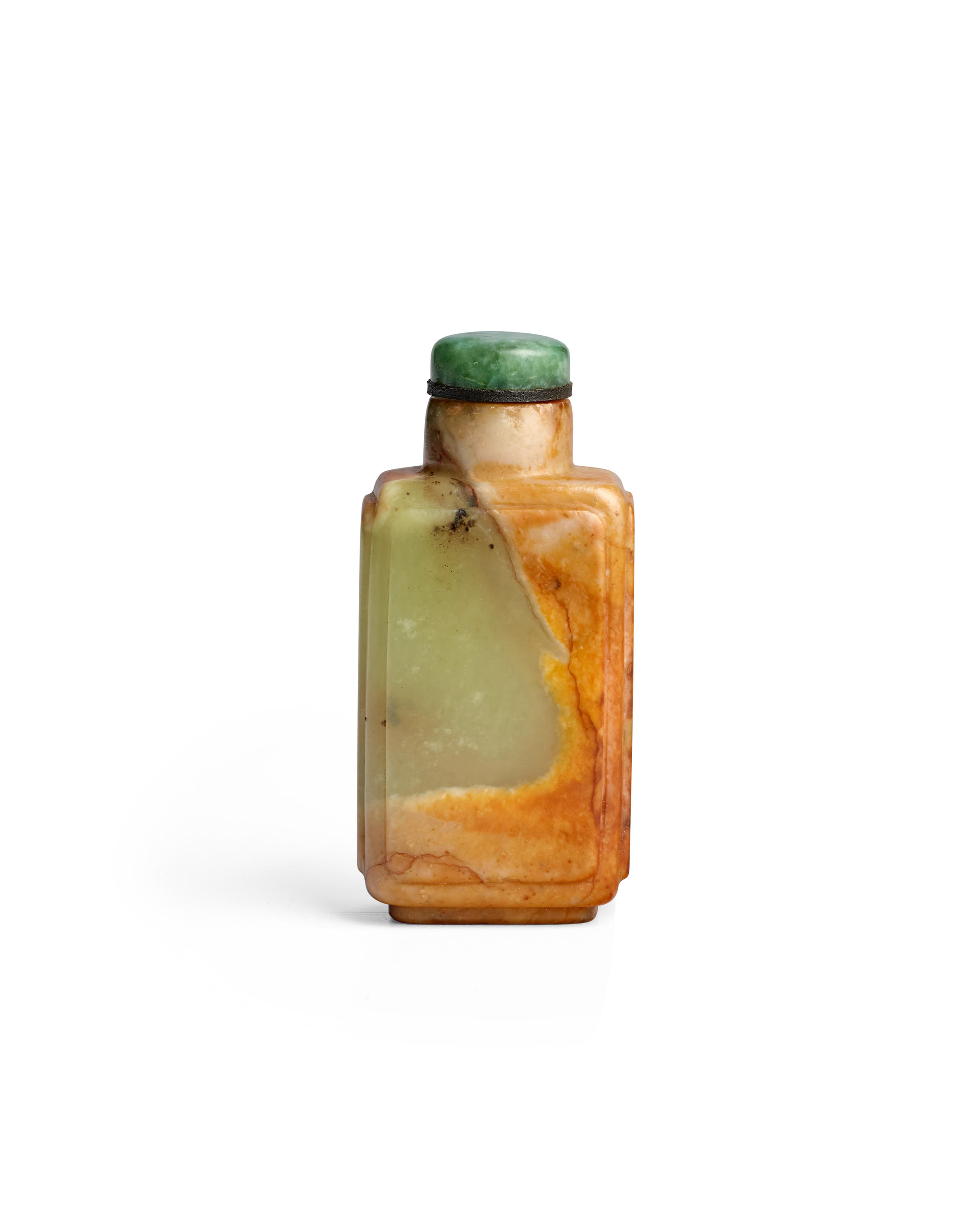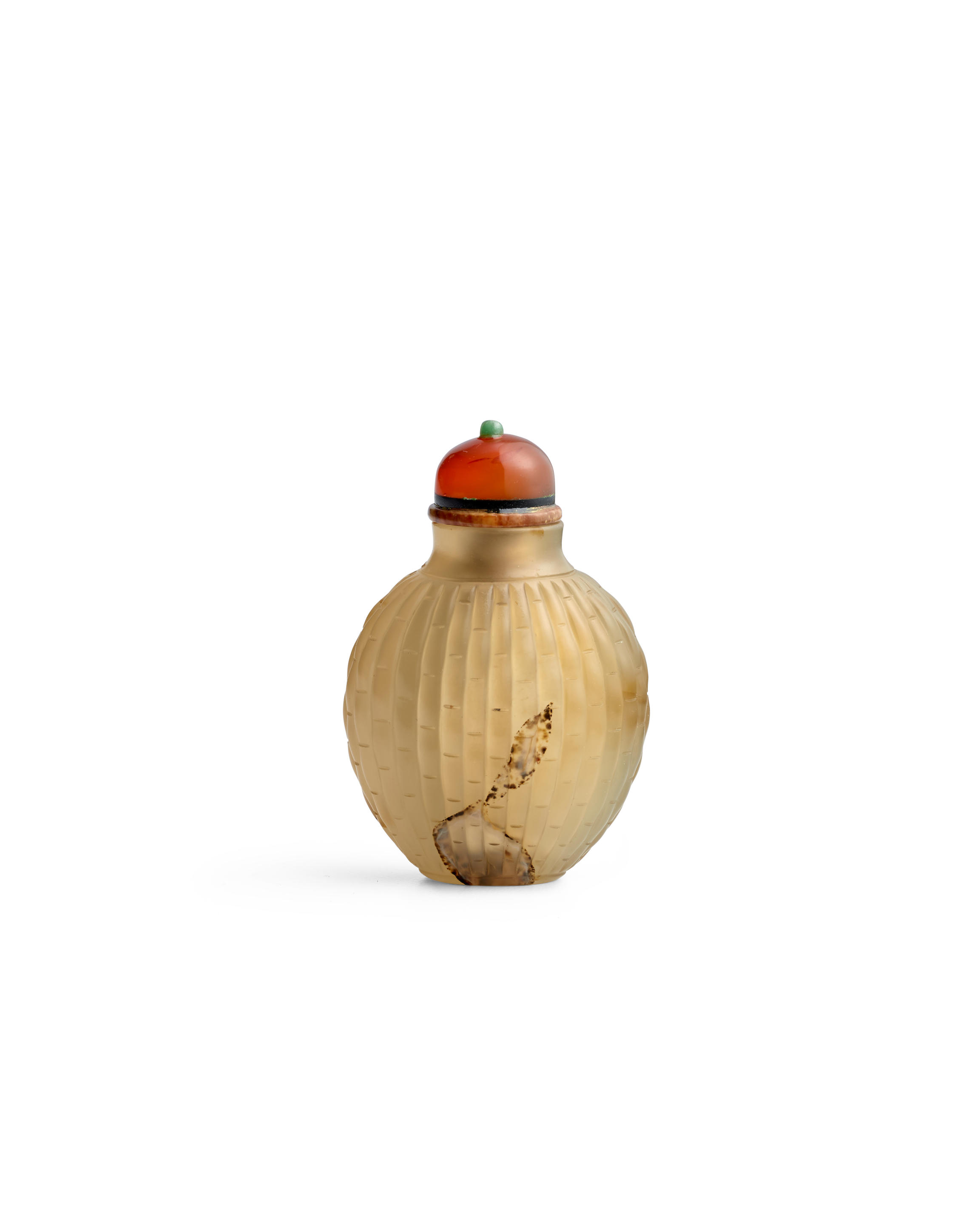A KESI MANDALA FRAGMENT WITH IMPERIAL PORTRAITSYuan Dynasty, second quarter of the 14th century
Originally the lower-right hand corner of a mandala, the fragment shows from the outer edge: the hats and faces of two Yuan dynasty empresses, the Yidam Hevajra and his Prajnya in a cartouche with lotus throne and surrounded by a flame border, a smaller cartouche of the same border with the Buddhist protector Acala raising a sword over his head, the concentric bands of a fire circle, a vajra circle, a circle containing sections of the eight graveyards, a circle of lotus petals, a makara on the upper-left corner partially spouting water from its mouth, and the vase Amrita Kalasha containing the Elixir of Life, with three lotus flowers representing long life; the dark blue ground filled with classic scrolling foliage and floral roundels, the right-hand side attached to an orange brocade border.
38 1/2 x 26 1/2in (98 x 67.5cm);
45 x 31 1/2in (114.3 x 80cm) with frameFootnotes元 緙絲曼陀羅之皇族供養人殘件
Provenance:
Spink, London, 1 March 1999
Published:
Threads of Imagination: Central Asian and Chinese Silks from the 12th to the 19th century, Spink, London, 1999, cat. no. 8
Exhibited:
Beyond the Great Wall: Cultural Features of China's Cowboy Neighbors, Museum of Fine Arts, Houston, 22 November 2003 - 29 February 2004.
來源:
倫敦Spink古董行,1999年03月01日
出版:
Threads of Imagination: Central Asian and Chinese Silks from the 12th to the 19th century,Spink古董行,倫敦,1999年,圖版編號8
展覽:
Beyond the Great Wall: Cultural Features of China's Cowboy Neighbors,休斯敦美術館,2003年11月22日 - 2004年2月29日
This mandala fragment belongs to the same set as the Vajrabhairava mandala in The Metropolitan Museum of Art, also known as Yamantaka Mandala with Imperial Portraits, acc. no. 1992.54 (fig. 1). Even in a fragmentary state, the present example conveys an immense artistic and historical presence and importance; it may be the only recorded example from the same imperial commission in private hands.
As James C. Y. Watt and Anne E. Wardwell state in the exhibition catalog When Silk Was Gold: Central Asian and Chinese Textiles, New York, 1997, pp. 95-98, cat. no. 25, the imperial order of the Metropolitan Museum's Vajrabhairava mandala was not recorded in Jingshi dadian (經世大典, Record of Yuan Institutions). However, they successfully argue, by reconciling important dates in the lives of the imperial subjects featured in the mandala with a compelling stylistic analysis of the imperial portraits along the bottom edge, the worship of Vajrabhairava as the central deity, and the size of the mandala, that the Metropolitan Museum's mandala was an imperial commission dating from 1330 to 1332. The present example from the Kooros Collection compares closely to the Metropolitan Museum's mandala for its superb workmanship in the kesi technique, the scale, the compositional structure, and the representational style of the empresses' portraits and other ritual features.
The two Yuan dynasty empresses depicted on the lower corner are Budashiri (ca. 1307 - ca. 1340, who acted as regent 1332-1339) and Babusha (d. 1330), the respective spouses of Tugh Temür (1304-1332, Khubilai Khan's great-grandson who reigned 1328-1329 and 1329-1332 as Emperor Wenzong) and Khoshila (1300-1329, elder brother of Tugh Temür who reigned briefly in 1329 as Emperor Mingzong). A Tibetan inscription in a cartouche above Babusha's head remains, while the cartouche above Budashiri has been cut away. Vertical strips originally extended from the cartouches that may have included the empresses' Chinese names now have been removed and replaced with kesi weavings to match the surroundings. Compare, for example, detail views of the Metropolitan Museum's mandala which show the same composition and removal of Chinese names (figs. 2, 3, 4).
Watt and Wardwell further summarized that "It is likely that this kesi was commissioned before the death of Babusha, in 1330, and completed after the death of Tugh Temür, in 1332. The subject of the mandala suggests that it may have been produced for an initiation ceremony. We know from his biography in the Yuanshi that Tugh Temür underwent two initiations as emperor and that Yamantaka initiations were practiced by the Yuan imperial family. However, because the paintings and kesi of imperial portraits and mandalas were always produced in triplicate or (more rarely) in duplicate, and because no mention of the occasion is ever given in connection with the orders, it is most probable that these portraits and mandalas were meant to be housed or displayed in the imperial ancestral halls and portrait halls (yingtang) for emperors and their consorts that were in temples connected with the imperial family. More than one copy of this kesi was made, and there is indeed a small fragment of the same mandala that is known to have survived" (ibid., p. 98). The present fragment from the Kooros Collection may be the one that is referenced by Watt and Wardwell as an iteration of the mandala in the Metropolitan Museum's collection.
Fig 1: Vajrabhairava mandala, Yuan dynasty, ca. 1330-32, The Metropolitan Museum of Art, 1992.54, Purchase, Lila Acheson Wallace Gift, 1992
Fig 2: Detail of Vajrabhairava mandala
Fig 3: Detail of present lot
Fig 4: Portrait of Empress Babusha, Taipei Palace Museum
A KESI MANDALA FRAGMENT WITH IMPERIAL PORTRAITSYuan Dynasty, second quarter of the 14th century
Originally the lower-right hand corner of a mandala, the fragment shows from the outer edge: the hats and faces of two Yuan dynasty empresses, the Yidam Hevajra and his Prajnya in a cartouche with lotus throne and surrounded by a flame border, a smaller cartouche of the same border with the Buddhist protector Acala raising a sword over his head, the concentric bands of a fire circle, a vajra circle, a circle containing sections of the eight graveyards, a circle of lotus petals, a makara on the upper-left corner partially spouting water from its mouth, and the vase Amrita Kalasha containing the Elixir of Life, with three lotus flowers representing long life; the dark blue ground filled with classic scrolling foliage and floral roundels, the right-hand side attached to an orange brocade border.
38 1/2 x 26 1/2in (98 x 67.5cm);
45 x 31 1/2in (114.3 x 80cm) with frameFootnotes元 緙絲曼陀羅之皇族供養人殘件
Provenance:
Spink, London, 1 March 1999
Published:
Threads of Imagination: Central Asian and Chinese Silks from the 12th to the 19th century, Spink, London, 1999, cat. no. 8
Exhibited:
Beyond the Great Wall: Cultural Features of China's Cowboy Neighbors, Museum of Fine Arts, Houston, 22 November 2003 - 29 February 2004.
來源:
倫敦Spink古董行,1999年03月01日
出版:
Threads of Imagination: Central Asian and Chinese Silks from the 12th to the 19th century,Spink古董行,倫敦,1999年,圖版編號8
展覽:
Beyond the Great Wall: Cultural Features of China's Cowboy Neighbors,休斯敦美術館,2003年11月22日 - 2004年2月29日
This mandala fragment belongs to the same set as the Vajrabhairava mandala in The Metropolitan Museum of Art, also known as Yamantaka Mandala with Imperial Portraits, acc. no. 1992.54 (fig. 1). Even in a fragmentary state, the present example conveys an immense artistic and historical presence and importance; it may be the only recorded example from the same imperial commission in private hands.
As James C. Y. Watt and Anne E. Wardwell state in the exhibition catalog When Silk Was Gold: Central Asian and Chinese Textiles, New York, 1997, pp. 95-98, cat. no. 25, the imperial order of the Metropolitan Museum's Vajrabhairava mandala was not recorded in Jingshi dadian (經世大典, Record of Yuan Institutions). However, they successfully argue, by reconciling important dates in the lives of the imperial subjects featured in the mandala with a compelling stylistic analysis of the imperial portraits along the bottom edge, the worship of Vajrabhairava as the central deity, and the size of the mandala, that the Metropolitan Museum's mandala was an imperial commission dating from 1330 to 1332. The present example from the Kooros Collection compares closely to the Metropolitan Museum's mandala for its superb workmanship in the kesi technique, the scale, the compositional structure, and the representational style of the empresses' portraits and other ritual features.
The two Yuan dynasty empresses depicted on the lower corner are Budashiri (ca. 1307 - ca. 1340, who acted as regent 1332-1339) and Babusha (d. 1330), the respective spouses of Tugh Temür (1304-1332, Khubilai Khan's great-grandson who reigned 1328-1329 and 1329-1332 as Emperor Wenzong) and Khoshila (1300-1329, elder brother of Tugh Temür who reigned briefly in 1329 as Emperor Mingzong). A Tibetan inscription in a cartouche above Babusha's head remains, while the cartouche above Budashiri has been cut away. Vertical strips originally extended from the cartouches that may have included the empresses' Chinese names now have been removed and replaced with kesi weavings to match the surroundings. Compare, for example, detail views of the Metropolitan Museum's mandala which show the same composition and removal of Chinese names (figs. 2, 3, 4).
Watt and Wardwell further summarized that "It is likely that this kesi was commissioned before the death of Babusha, in 1330, and completed after the death of Tugh Temür, in 1332. The subject of the mandala suggests that it may have been produced for an initiation ceremony. We know from his biography in the Yuanshi that Tugh Temür underwent two initiations as emperor and that Yamantaka initiations were practiced by the Yuan imperial family. However, because the paintings and kesi of imperial portraits and mandalas were always produced in triplicate or (more rarely) in duplicate, and because no mention of the occasion is ever given in connection with the orders, it is most probable that these portraits and mandalas were meant to be housed or displayed in the imperial ancestral halls and portrait halls (yingtang) for emperors and their consorts that were in temples connected with the imperial family. More than one copy of this kesi was made, and there is indeed a small fragment of the same mandala that is known to have survived" (ibid., p. 98). The present fragment from the Kooros Collection may be the one that is referenced by Watt and Wardwell as an iteration of the mandala in the Metropolitan Museum's collection.
Fig 1: Vajrabhairava mandala, Yuan dynasty, ca. 1330-32, The Metropolitan Museum of Art, 1992.54, Purchase, Lila Acheson Wallace Gift, 1992
Fig 2: Detail of Vajrabhairava mandala
Fig 3: Detail of present lot
Fig 4: Portrait of Empress Babusha, Taipei Palace Museum















Try LotSearch and its premium features for 7 days - without any costs!
Be notified automatically about new items in upcoming auctions.
Create an alert